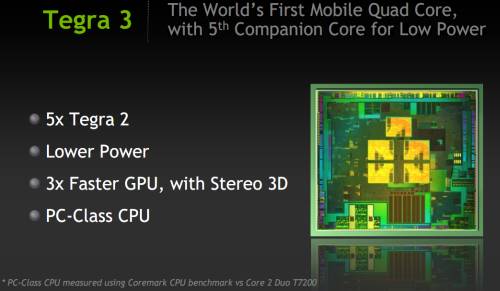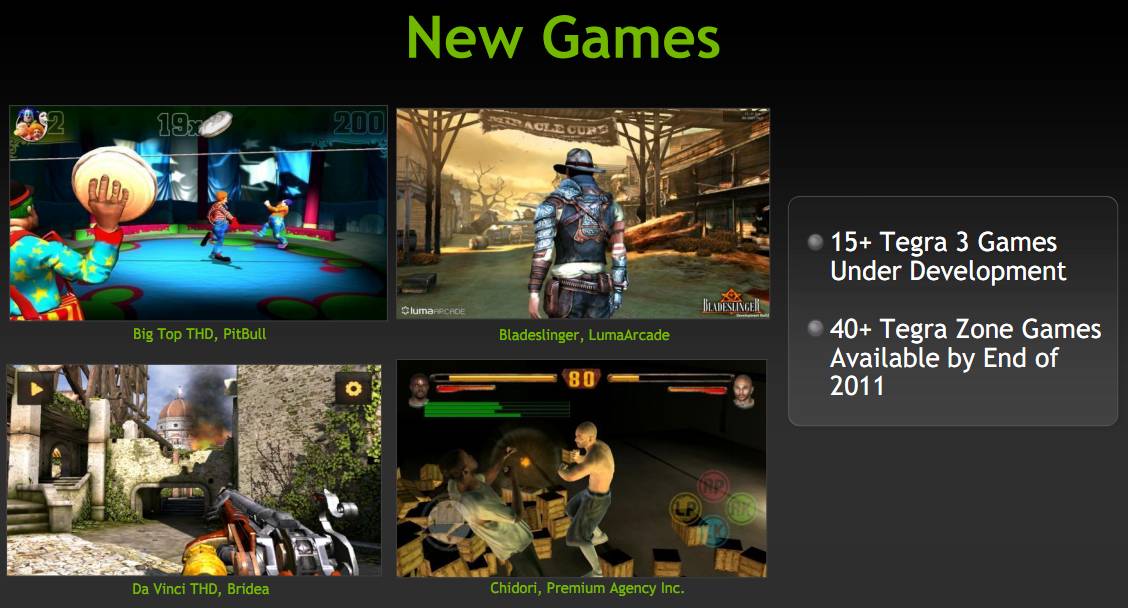
NVIDIA has officially introduced its next-generation mobile processor. The NVIDIA Tegra 3 chip is a 1.4 GHz ARM Cortex-A9 multi-core processor with 4 high performance CPU cores, 1 extra low power “companion” core, and 12 graphics cores.
The new chips are headed to tablets and smartphones. The first Tegra 3 device will be the Asus Eee Pad Transformer Prime, which is expected to launch today. Other tablets will follow, and NVIDIA says the first Tegra 3-powered smartphones could arrive in early 2012.
Up until recently NVIDIA had been referring to the Tegra 3 chip by its codename, Kal-El, but now the company is dropping the codenames and just referring to the mobile processor as Tegra 3.
NVIDIA says the processor offers 5 times the processing performance of the NVIDIA Tegra 2 chip which has dominated the Android tablet space for much of the year. It also offers 3 times better graphics performance with support for detailed graphics effects including dynamic lighting and shadow effects.
But while the new chip is one of the most powerful ARM-based processors around, it also uses less power than previous Tegra chips. NVIDIA says the Eee Pad Transformer Prime, for instance, should get about 12 hours of battery life — and that’s without using the optional keyboard dock which has an extra battery.

One of the reasons for the improved power consumption is the way the chips multiple cores work together. When you’re performing tasks that benefit from multi-threading, multiple cores will kick into action. But for many tasks you only need one processor core, or maybe two. In those situations, the extra cores can shut down altogether.

The four main processing cores can operate at speeds up to 1.4 Ghz — but they can also run at lower speeds. And the fifth companion core can handle a surprisingly large number of duties on its own. It has a top clock speed of just 500 MHz, but it’s the only CPU core you need to watch 1080p HD video, listen to music or perform more basic tasks.

When surfing the web, for instance, the main processing cores will help load web pages quickly. But they can then shut off as you read so that the low power companion core is the only one drawing energy as you scan the page.
NVIDIA says the technology is designed so that it will work with a wide range of apps, regardless of whether they were designed to take advantage of the Tegra 3 chip’s multithreading capabilities.
But apps that were developed with Tegra 3 in mind can take advantage of some of the advance graphics capabilities. For instance, NVIDIA is showing off demos of a few games that have been designed to run on both Tegra 2 and Tegra 3 devices. The Tegra 2 versions look pretty great for mobile games… but the Tegra 3 versions can support richer textures and advanced physics.
For instance, the water-racing game Riptide runs on devices with either chip — but the Tegra 3 version adds support for motio blur effects and water spray visuals — with reflections showing up in each drop of water as it splashes.
There are currently more than 15 games under development that are designed specifically to work with NVIDIA’s Tegra 3 chip.

Speaking of gaming, NVIDIA has added support for third party video game controllers to the platform. The company will offer software to its partners so that you’ll be able to easily pair a Playstation 3, Xbox 360, or Nintendo Wii tablet with a phone or tablet. Other game controllers will be supported as well.
The chipset also supports stereoscopic 3D graphics — and it can convert 2D games or videos to 3D in real-time and output the content to a 3D TV or monitor via an HDMI 1.4 connection.

Graphics aren’t just for gaming though. NVIDIA says Tegra 3 also offers hardware acceleration for Adobe Flash, HTML5, WebGL, and other web technologies, which should lead to faster page load speeds and better support for rich media content on the web.

The speed boost will also help enable support for desktop-style applications. Tablets are often seen as content consumption devices rather than computers for content creation.
But as the chips get faster they’ll be better equipped to offer support for features such as video transcoding or photo stitching — which NVIDIA says the Tegra 3 chip can handle twice as fast as other mobile chips.

While the Tegra 3 will likely show up first in Android phones and tablets, eventually we may see this processor in Windows tablets and laptops. Microsoft Windows 8 will be the first full version of the Windows operating system to support ARM-based processors, and at that point NVIDIA won’t just be competing with Qualcomm, Texas Instruments, and Samsung, but also Intel and AMD.














Much as I dislike NVIDIA on account of the “bumpgate“ melting laptop graphics card which destroyed one of my laptops, this 4 cores + one low power core for good measure is a clear one finger salute to it`s competitors! Others said it was not worth doing at 40nm…well those nay sayers are looking at the king of the hill at the very least until we get to 28nm and that will not be much before summer 2012.